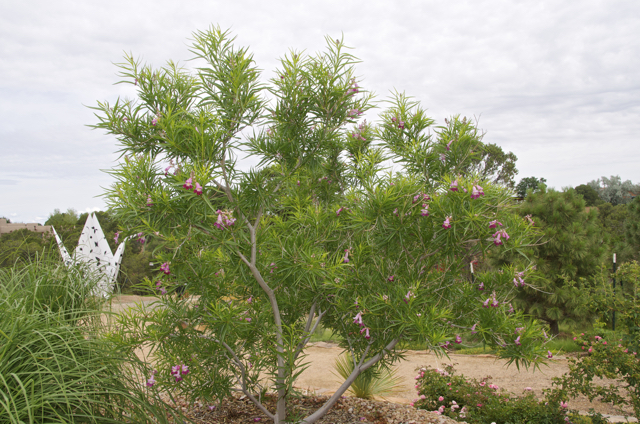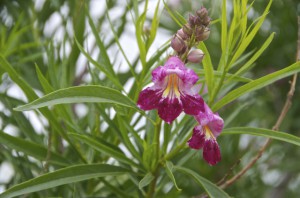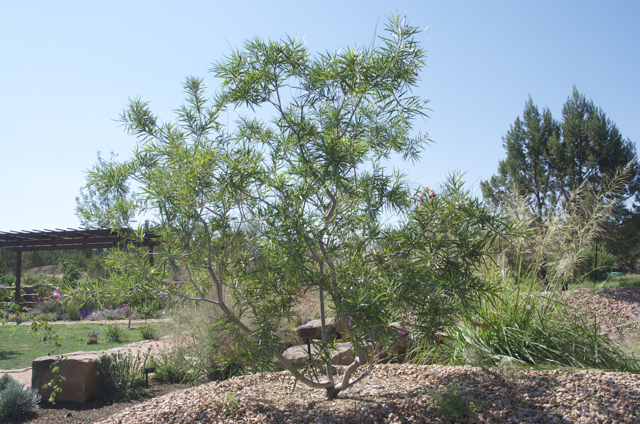Scientific name: Chilopsis linearis ART’S SEEDLESS ™
Common name: ART’S SEEDLESS™ desert willow, desert catalpa
Plant Family: Bignoniaceae– Catalpa
Article and photos by Janice Tucker
Lagniappe (lanny-yap) – A little something extra.
Trees with showy flowers could be called “lagniappe trees” because in addition to shade, vertical interest and texture, they give the garden that little something extra. The Chilopsis linearis, commonly known as the desert willow or the desert catalpa goes the extra distance by enticing us to pause and enjoy its showy flowers and their tantalizing fragrance.

Photo by Janice Tucker
Native to New Mexico, southwestern Texas, extreme southwestern areas of Utah and southern California, the Chilopsis linearis (desert willow) is a deciduous small tree or large shrub that prefers elevations of 1000’ to a bit over 5000’. Its natural habitats are in the moist soil of stream banks, drainage ditches, in plains and foothills as well as desert grasslands. It often reproduces rapidly, forming large stands and thickets.
The Chilopsis linearis, which matures to a height and width of 20 to 25 feet, is an ideal focal plant for the home garden. It is often trimmed into a small tree with branches spreading out from a slightly leaning trunk. The alternate, long, light green, curved, thin leaves and the slender branches are similar to those of a willow tree even though the two trees are not related. The Chilopsis linearis (desert willow) is in the Bignoniaceae plant family, while the Salix genus (willow) is in the Salicaceae plant family. It is also commonly called a desert catalpa. The Chilopsis and Catalpa could claim to be kissing cousins since both genera are in the same plant family. The flowers and seedpods are similar but the leaves of the Catalpa are broad and heart-shaped. Catalpa growing regions can differ with the Chilopsis linearis depending on the species.

Photo by Janice Tucker
That “something extra” begins in spring when flower clusters appear at the ends of new twigs. Blooming one or two at a time from each cluster, the burgundy to light pink, tubular, orchid-like flowers adorn the tree like carefully placed ornaments, releasing a fragrance of vanilla or violets. These lovely flowers continue to wow us from spring through autumn. The 1 to 3 inch flowers have 5 unequal lobes with yellow and burgundy stripes that fan out from deep throats toward the lower, lip-like lobes.
In autumn, the species Chilopsis linearis produces pods of brown, slender bean-like fruit. These pods split in the middle, spilling a multitude of flat, brown seeds. Each seed has two hairy, paper-like wings to assist the wind in propagation. Propagation can also be accomplished with cuttings.
The Chilopsis linearis is a prolific seeder, grows rapidly and sprouts after cutting, all of which could cause some overgrowth frustrations in home gardens and formal landscapes. The ART’S SEEDLESS ™ cultivar was developed and trademarked by respected plantsman, Art Combe. It produces beautiful, but sterile flowers that do not go to seed. Another seedless cultivar is the TIMELESS BEAUTY®, which is valued for its extended blooming time as well as the absence of seedpods. These seedless cultivars allow gardeners the option of enjoying the plant without worrying about controlling overgrowth. The Chilopsis linearis ART’S SEEDLESS ™ can be seen in the Botanical Garden at Museum Hill.

Photo by Janice Tucker
The Chilopsis linearis is fairly pest and disease resistant. Plant it in full sun and sandy or any well-draining soil. Overwatering and poor drainage can cause root rot. It enjoys the dry climates of the U. S. Southwest ensuring low water requirements after it has been established. Even though it is not a high-maintenance plant, light pruning is recommended to increase blooms since it flowers on new wood. But please note that a large part of the Chilopsis linearis’ attraction is its natural growth habit. Therefore, care should be taken when pruning so as not to totally reshape the tree – that “willowy” look is exactly what you want. It is cold tolerant to -10℉, and grows in USDA Zones 5 -11. Bees and hummingbirds cannot resist the nectar of the long-throated flowers. Orioles are also frequent visitors. The seedpods of the species plant provide winter food for a variety of birds.
Chilopsis (kye-LOP-sis) is from the Greek, cheilos, meaning “lip”, and opsis, which means “resembling”. A quick look at the flowers shows lower, lip-shaped lobes. The species linearis (lin-AIR-iss) is defined as linear or lined, most likely referring to the slender branches and leaves. Chilopsis is a monotypic genus with only the species linearis. There are, however, an increasing number of cultivars of the Chilopsis linearis.
Chilopsis linearis is useful in erosion control and is also a highly desirable ornamental plant in a home or public garden. Native Americans used the wood to make bows. Because of its durability, the wood is also used for fence posts.
Every garden should have a “lagniappe plant”. The Chilopsis linearis certainly possesses that little something extra.
Sources Consulted:
National Audubon Society, Field Guide to Trees, Western Region, Alfred A. Knopf, Inc, New York, New York, Copyright 1980 by Chanticleer Press, Inc.
The Plant List, Missouri Botanical Garden, http://www.theplantlist.org/tpl1.1/search?q=Chilopsis+linearis
Golden West College, Plant of the Month, July 2010, Chilopsis linearis, www.goldenwestcollege.edu.
Texas Native Plants Database, Desert Willow, Flowering Willow, Willowleaf Catalpa, Desert Catalpa, Flor de Mimbre, Bow Willow, aggie-horticulture.tamu.edu, January 22, 2015.
Arizona State University, Chilopsis linearis, www.public.asu.edu
Mountain States Wholesale Nursery, Chilopsis Linearis ART’S SEEDLESS ™ Seedless Desert Willow, www.mswn.com.
Dave’s Garden, Welcome to Botanary, www.davesgarden.com.
Stearn, William T., Stearn’s Dictionary of Plant Names for Gardeners, A Handbook on the Origin and Meaning of the Botanical Names of some Cultivated Plants, Cassell Wellington House, 125 Strand, London WC2R OBB, 1996
Phillps, Judith, The What, Where, When, How & Why of Gardening in New Mexico – New Mexico Gardener’s Guide, Cool Springs Press, Inc., 206 Bridge Street, Franklin, Tennessee, Copyright 1998.
Galer, Anne, Plant in the Spotlight (Chilopsis linearis), American Gardener Magazine, http://d27vj430nutdmd.cloudfront.net/17914/74350/74350.7.pdf, July/August 2011.
Thanks to Helen Woody for proofreading this article.


